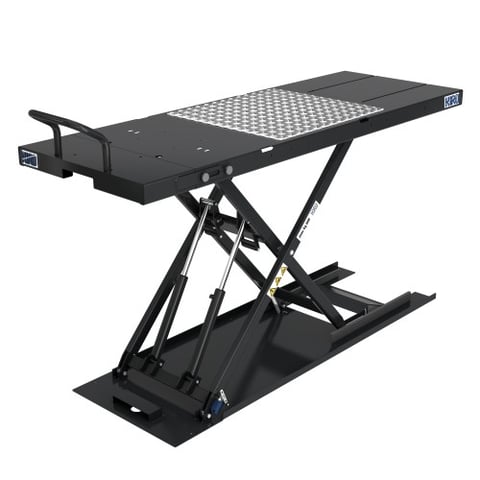
Whether for professional or hobby use, the practicality and impact on productivity of a motorcycle lift deck are cross-cutting features.
These tools are essential for routine maintenance, performing major overhauls, or simply cleaning the motorcycle.
But how exactly does a lift bridge work?
We look at it in today's article.
Types of motorcycle lift table
There are three main types of motorcycle lift bridges on the market, classified according to the type of power supply:
- pneumatic
- hydro-pneumatic
- electro-hydraulic
Let's go into detail.
Pneumatic motorcycle lift table
This type of lift is very common in workshops and is equipped with a manual foot pump to raise or lower them.
Hydro-pneumatic lift bridge
The second type of motorcycle lifts is operated by a manual foot pedal, along with the aid of compressed air.
Hydro-pneumatic lifts are known for their smooth operation: the system allows the lift to operate up and down without the oscillations sometimes seen with pneumatic lifts.
Electrohydraulic lift table
The third type of motorcycle lift is powered by an electrohydraulic control unit that manages the movement of the bridge.
Workshops often tend to install this type of bridge for two main reasons:
- convenience of power supply
- constant operating speed and pressure
How a motorcycle lift table works
A lift bridge is an essential tool in a motorcycle workshop, as it allows the motorcycle to be lifted off the ground for easy access to different parts of the vehicle, thus simplifying maintenance, repair and inspection.
There are several types of lift bridges, but this explanation will focus on the operation of a scissor lift bridge, as it is one of the most common.

First of all, it should be clarified that a scissor lift bridge consists of two metal arms connected together in the shape of an "X" or, indeed, "scissor." These arms are mounted on a stable base and can be operated by a pneumatic, hydro-pneumatic and electro-hydraulic system as we saw earlier.
On these arms then rests the upper platform of the bridge, which is equipped with possible various options that allow the motorcycle to be firmly positioned.
When the bridge is lowered, the platform is level with the floor of the workshop-thanks to the burying of the bridge or the presence of ramps-allowing easy loading and unloading of the vehicle.
Let's now look at what happens during the lifting and lowering phases of the bridge.
Lifting
By actuating the hydraulic pump or corresponding system, hydraulic oil or compressed air is directed into the hydraulic cylinders mounted on the scissor arms.
This creates a lifting force that slowly raises the platform and, consequently, the motorcycle placed on it.
The lifting speed can be adjusted as needed, as can the height of the deck.
Lowering
Once the work is completed, the operator can gradually release the pressure in the hydraulic system or corresponding system.
This will allow the platform to slowly lower itself back to workshop floor level so that the motorcycle can be safely unloaded.
It is important to note that the use of a lifting platform requires care and precaution to ensure the safety of both the operator and the motorcycle.
Following the manufacturer's instructions and adopting recommended safety practices is critical when using any equipment in a motorcycle workshop.
If you are looking for a high-performance motorcycle lift that meets the highest safety standards, take a look at the KIRO product range.
If you would then like more detailed information, contact us for a free consultation.
